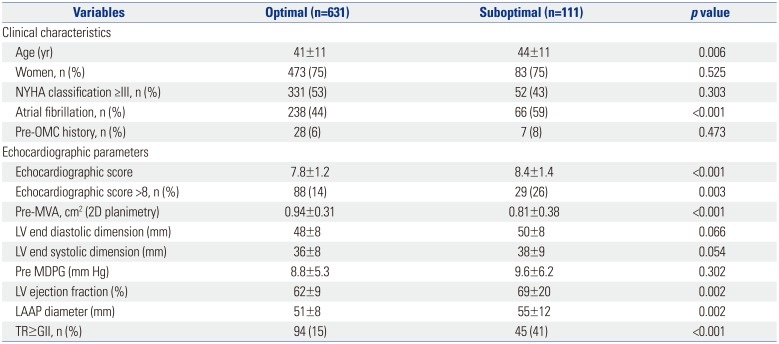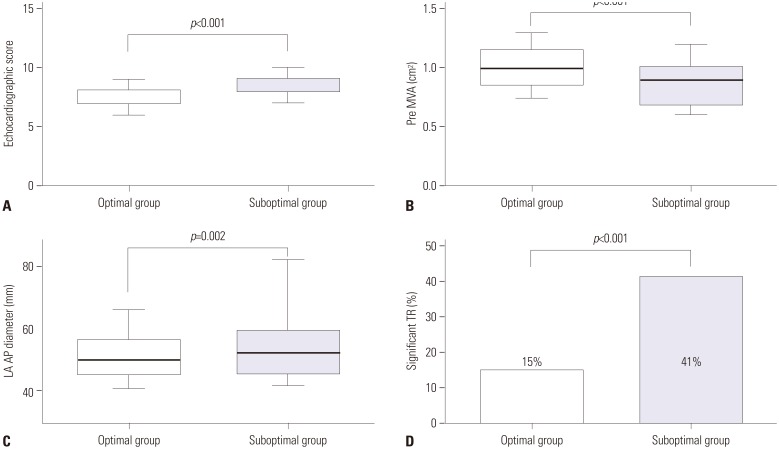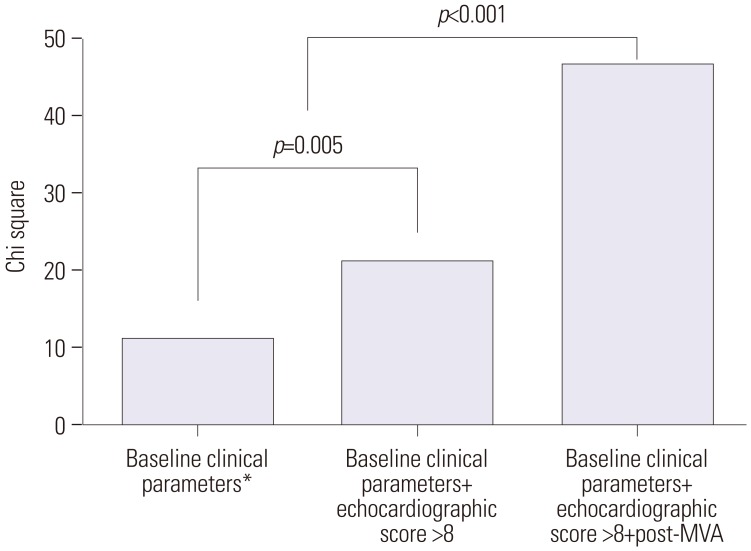1. Iung B, Garbarz E, Michaud P, Fondard O, Helou S, Kamblock J, et al. Immediate and mid-term results of repeat percutaneous mitral commissurotomy for restenosis following earlier percutaneous mitral commissurotomy. Eur Heart J. 2000; 21:1683–1689. PMID:
11032695.

2. Hernandez R, Bañuelos C, Alfonso F, Goicolea J, Fernández-Ortiz A, Escaned J, et al. Long-term clinical and echocardiographic follow-up after percutaneous mitral valvuloplasty with the Inoue balloon. Circulation. 1999; 99:1580–1586. PMID:
10096934.

3. Iung B, Garbarz E, Michaud P, Helou S, Farah B, Berdah P, et al. Late results of percutaneous mitral commissurotomy in a series of 1024 patients. Analysis of late clinical deterioration: frequency, anatomic findings, and predictive factors. Circulation. 1999; 99:3272–3278. PMID:
10385502.
4. Nishimura RA, Otto CM, Bonow RO, Carabello BA, Erwin JP 3rd, Guyton RA, et al. 2014 AHA/ACC guideline for the management of patients with valvular heart disease: executive summary: a report of the American College of Cardiology/American Heart Association Task Force on Practice Guidelines. J Am Coll Cardiol. 2014; 63:2438–2488. PMID:
24603192.
5. Bouleti C, Iung B, Laouénan C, Himbert D, Brochet E, Messika-Zeitoun D, et al. Late results of percutaneous mitral commissurotomy up to 20 years: development and validation of a risk score predicting late functional results from a series of 912 patients. Circulation. 2012; 125:2119–2127. PMID:
22456478.
6. Chen CR, Cheng TO, Chen JY, Zhou YL, Mei J, Ma TZ. Long-term results of percutaneous mitral valvuloplasty with the Inoue balloon catheter. Am J Cardiol. 1992; 70:1445–1448. PMID:
1442616.

7. Palacios IF, Sanchez PL, Harrell LC, Weyman AE, Block PC. Which patients benefit from percutaneous mitral balloon valvuloplasty? Prevalvuloplasty and postvalvuloplasty variables that predict long-term outcome. Circulation. 2002; 105:1465–1471. PMID:
11914256.

8. Song JK, Kim MJ, Yun SC, Choo SJ, Song JM, Song H, et al. Long-term outcomes of percutaneous mitral balloon valvuloplasty versus open cardiac surgery. J Thorac Cardiovasc Surg. 2010; 139:103–110. PMID:
19660411.

9. Dean LS. Percutaneous transvenous mitral commissurotomy: a comparison to the closed and open surgical techniques. Cathet Cardiovasc Diagn. 1994; (Suppl 2):76–81.
10. Cohen DJ, Kuntz RE, Gordon SP, Piana RN, Safian RD, McKay RG, et al. Predictors of long-term outcome after percutaneous balloon mitral valvuloplasty. N Engl J Med. 1992; 327:1329–1335. PMID:
1406834.

11. Stefanadis CI, Stratos CG, Lambrou SG, Bahl VK, Cokkinos DV, Voudris VA, et al. Retrograde nontransseptal balloon mitral valvuloplasty: immediate results and intermediate long-term outcome in 441 cases--a multicenter experience. J Am Coll Cardiol. 1998; 32:1009–1016. PMID:
9768726.

12. Bouleti C, Iung B, Himbert D, Brochet E, Messika-Zeitoun D, Détaint D, et al. Reinterventions after percutaneous mitral commissurotomy during long-term follow-up, up to 20 years: the role of repeat percutaneous mitral commissurotomy. Eur Heart J. 2013; 34:1923–1930. PMID:
23514935.

13. Wilkins GT, Weyman AE, Abascal VM, Block PC, Palacios IF. Percutaneous balloon dilatation of the mitral valve: an analysis of echocardiographic variables related to outcome and the mechanism of dilatation. Br Heart J. 1988; 60:299–308. PMID:
3190958.

14. Cruz-Gonzalez I, Sanchez-Ledesma M, Sanchez PL, Martin-Moreiras J, Jneid H, Rengifo-Moreno P, et al. Predicting success and long-term outcomes of percutaneous mitral valvuloplasty: a multifactorial score. Am J Med. 2009; 122:581.e11–581.e19.

15. Kim JB, Ha JW, Kim JS, Shim WH, Kang SM, Ko YG, et al. Comparison of long-term outcome after mitral valve replacement or repeated balloon mitral valvotomy in patients with restenosis after previous balloon valvotomy. Am J Cardiol. 2007; 99:1571–1574. PMID:
17531583.

16. Kang DH, Park SW, Song JK, Kim HS, Hong MK, Kim JJ, et al. Long-term clinical and echocardiographic outcome of percutaneous mitral valvuloplasty: randomized comparison of Inoue and double-balloon techniques. J Am Coll Cardiol. 2000; 35:169–175. PMID:
10636276.
17. Wang A, Krasuski RA, Warner JJ, Pieper K, Kisslo KB, Bashore TM, et al. Serial echocardiographic evaluation of restenosis after successful percutaneous mitral commissurotomy? J Am Coll Cardiol. 2002; 39:328–334. PMID:
11788227.

18. Palacios IF. What is the gold standard to measure mitral valve area postmitral balloon valvuloplasty. Cathet Cardiovasc Diagn. 1994; 33:315–316. PMID:
7889548.

19. Cho IJ, Hong GR, Lee SH, Lee S, Chang BC, Shim CY, et al. Prosthesis-patient mismatch after mitral valve replacement: comparison of different methods of effective orifice area calculation. Yonsei Med J. 2016; 57:328–336. PMID:
26847283.

20. Iung B, Baron G, Butchart EG, Delahaye F, Gohlke-Bärwolf C, Levang OW, et al. A prospective survey of patients with valvular heart disease in Europe: The Euro Heart Survey on Valvular Heart Disease. Eur Heart J. 2003; 24:1231–1243. PMID:
12831818.

21. Elasfar AA, Elsokkary HF. Predictors of developing significant mitral regurgitation following percutaneous mitral commissurotomy with inoue balloon technique. Cardiol Res Pract. 2011; 2011:703515. PMID:
21876824.

22. Meneveau N, Schiele F, Seronde MF, Breton V, Gupta S, Bernard Y, et al. Predictors of event-free survival after percutaneous mitral commissurotomy. Heart. 1998; 80:359–364. PMID:
9875112.

23. Abascal VM, Wilkins GT, O'Shea JP, Choong CY, Palacios IF, Thomas JD, et al. Prediction of successful outcome in 130 patients undergoing percutaneous balloon mitral valvotomy. Circulation. 1990; 82:448–456. PMID:
2372892.

24. Nunes MC, Tan TC, Elmariah S, do Lago R, Margey R, Cruz-Gonzalez I, et al. The echo score revisited: impact of incorporating commissural morphology and leaflet displacement to the prediction of outcome for patients undergoing percutaneous mitral valvuloplasty. Circulation. 2014; 129:886–895. PMID:
24281331.
25. Song JK, Song JM, Kang DH, Yun SC, Park DW, Lee SW, et al. Restenosis and adverse clinical events after successful percutaneous mitral valvuloplasty: immediate post-procedural mitral valve area as an important prognosticator. Eur Heart J. 2009; 30:1254–1262. PMID:
19346230.

26. Kim MJ, Song JK, Song JM, Kang DH, Kim YH, Lee CW, et al. Longterm outcomes of significant mitral regurgitation after percutaneous mitral valvuloplasty. Circulation. 2006; 114:2815–2822. PMID:
17159061.

27. Essop MR, Wisenbaugh T, Skoularigis J, Middlemost S, Sareli P. Mitral regurgitation following mitral balloon valvotomy. Differing mechanisms for severe versus mild-to-moderate lesions. Circulation. 1991; 84:1669–1679. PMID:
1914106.









 PDF
PDF ePub
ePub Citation
Citation Print
Print




 XML Download
XML Download